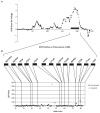STAT4 and the risk of rheumatoid arthritis and systemic lupus erythematosus
- PMID: 17804842
- PMCID: PMC2630215
- DOI: 10.1056/NEJMoa073003
STAT4 and the risk of rheumatoid arthritis and systemic lupus erythematosus
Abstract
Background: Rheumatoid arthritis is a chronic inflammatory disease with a substantial genetic component. Susceptibility to disease has been linked with a region on chromosome 2q.
Methods: We tested single-nucleotide polymorphisms (SNPs) in and around 13 candidate genes within the previously linked chromosome 2q region for association with rheumatoid arthritis. We then performed fine mapping of the STAT1-STAT4 region in a total of 1620 case patients with established rheumatoid arthritis and 2635 controls, all from North America. Implicated SNPs were further tested in an independent case-control series of 1529 patients with early rheumatoid arthritis and 881 controls, all from Sweden, and in a total of 1039 case patients and 1248 controls from three series of patients with systemic lupus erythematosus.
Results: A SNP haplotype in the third intron of STAT4 was associated with susceptibility to both rheumatoid arthritis and systemic lupus erythematosus. The minor alleles of the haplotype-defining SNPs were present in 27% of chromosomes of patients with established rheumatoid arthritis, as compared with 22% of those of controls (for the SNP rs7574865, P=2.81x10(-7); odds ratio for having the risk allele in chromosomes of patients vs. those of controls, 1.32). The association was replicated in Swedish patients with recent-onset rheumatoid arthritis (P=0.02) and matched controls. The haplotype marked by rs7574865 was strongly associated with lupus, being present on 31% of chromosomes of case patients and 22% of those of controls (P=1.87x10(-9); odds ratio for having the risk allele in chromosomes of patients vs. those of controls, 1.55). Homozygosity of the risk allele, as compared with absence of the allele, was associated with a more than doubled risk for lupus and a 60% increased risk for rheumatoid arthritis.
Conclusions: A haplotype of STAT4 is associated with increased risk for both rheumatoid arthritis and systemic lupus erythematosus, suggesting a shared pathway for these illnesses.
Copyright 2007 Massachusetts Medical Society.
Figures



Comment in
-
Rheumatoid arthritis, systemic lupus erythematosus, and STAT4.N Engl J Med. 2007 Dec 13;357(24):2517-8; author reply 2518. doi: 10.1056/NEJMc072855. N Engl J Med. 2007. PMID: 18077818 No abstract available.
References
-
- Goronzy J, Weyand C. Rheumatoid arthritis. A. Epidemiology, pathology, and pathogenesis. In: Klippel J, Crofford L, Stone J, Weyand C, editors. Primer on the rheumatic diseases. 12th ed. Arthritis Foundation; Atlanta: 2001. pp. 209–17.
-
- MacGregor AJ, Snieder H, Rigby AS, et al. Characterizing the quantitative genetic contribution to rheumatoid arthritis using data from twins. Arthritis Rheum. 2000;43:30–7. - PubMed
-
- Seldin MF, Amos CI, Ward R, Gregersen PK. The genetics revolution and the assault on rheumatoid arthritis. Arthritis Rheum. 1999;42:1071–9. - PubMed
-
- Wordsworth BP, Bell JI. The immunogenetics of rheumatoid arthritis. Springer Semin Immunopathol. 1992;14:59–78. - PubMed
Publication types
MeSH terms
Substances
Grants and funding
- M01 RR000079/RR/NCRR NIH HHS/United States
- R01 AR050267/AR/NIAMS NIH HHS/United States
- R01 AR-44804/AR/NIAMS NIH HHS/United States
- R01 AR44422/AR/NIAMS NIH HHS/United States
- N01-AR-2-2263/AR/NIAMS NIH HHS/United States
- N01-AI95386/AI/NIAID NIH HHS/United States
- R01 AR052300/AR/NIAMS NIH HHS/United States
- N01-AR-1-2256/AR/NIAMS NIH HHS/United States
- K08 AI055314/AI/NIAID NIH HHS/United States
- N01 AI095386/AI/NIAID NIH HHS/United States
- M01 RR018535/RR/NCRR NIH HHS/United States
- R01 AR044422/AR/NIAMS NIH HHS/United States
- 5-M01-RR-00079/RR/NCRR NIH HHS/United States
LinkOut - more resources
Full Text Sources
Other Literature Sources
Medical
Molecular Biology Databases
Research Materials
Miscellaneous
